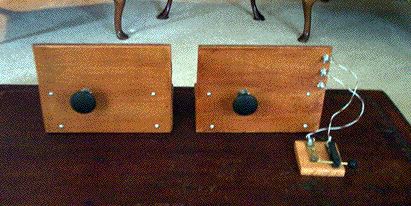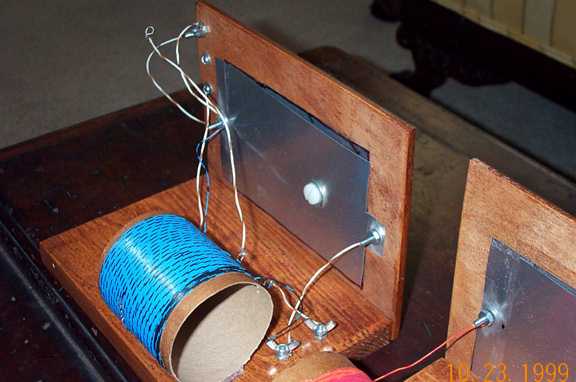Owen's set
Photo and Text information
Owen also has a web site for his radio it is http://www.glynn.k12.ga.us/~opool/entry/compressotron.htm
The Compressotron
Crystal Receiver and Companion Antenna Tuner
by Owen Pool WB4LFH
This receiver is designed to be operated as a stand
alone receiver or in conjunction with the companion antenna tuner.
It is a "hardware store" special, except for the wire (scavenged from a
telephone cable), a craft bead, some nichrome wire (nipped from a
physics lab storeroom), and the galena crystal (found in the same storeroom).
The design is rather straightforward: The receiver uses a solenoid
wound coil with two detector taps, and connections for an antenna
and ground. Connections are made using wing nuts. The antenna
tuner, also of conventional design, may be configured for either
serial or parallel operation.
Unusual construction features are the compression
capacitor design, stolen elsewhere, and the clothespin holder for the catwhisker
rod (original for me, at least).
Operation of the set, with the singular exception
of the detector, quite frankly stunk. Oh yes, I was able to pick
up the locals and a few of the bandmarker dx stations, such as WSM and
WBT, but the capacitors were so touchy that tuning was a frustrating exercise,
and quickly abandoned. The T-nuts used for holding the tuning bolts
(hidden behind the furniture knobs), were cut short to match the front
panel thickness, and contributed greatly to slop in tuning, as did the
nylon bolts, selected to reduce hand capacitance, but which fit rather
loosely in the threaded T-nuts. Adding to this was the aluminum flashing
used for the 3" x 5" capacitor plates, which tended to wobble during tuning.
I may go this way again, but I might not, and I won't complain about the
price of air variables any more.

Notice the absence of fancy switching and labels. This is a one-man
rig, and definitely not ready for prime time. Besides, I hate to
throw good money and time after bad. Any needed connection changes
are made by taps led out to wing nuts.


Rear view of receiver, showing detail of two-plate capacitor.
The dangling wire is one of the two detector taps, ready to wing nut into
place.
(dates on pictures came with the borrowed digital camera)

The detector stand. This worked fine and holds a point well.
The rock is held down by a modified safety pin. Should have just
entered it and forgotten about the rest.



